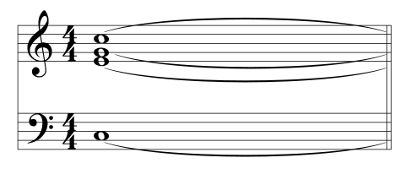2.1 Musical symbols
The durations of notes and rests is represented graphically using a series of special musical symbols. Obviously, even for the duration of sounds it is indispensable to have a unit of measurement, just as it is for length (the metre) and weight (the gram) etc.
This unit of measurement is called the Semibreve (or Whole Note in the USA). This, however, does not have an absolute value, but depends upon the tempo indication at the beginning of the piece (Allegro, Adagio, etc.) (1)
For each note there is a corresponding rest of equal value.
The different notes are listed in the table below, along with their equivalent rests and time value. (2)
The stave is divided into bars. A bar is the space on the stave between two bar lines.
Within the bar the notes and rests must add up to the bar length indicated by the “Time Signature” at the beginning of the piece. In printed music the time signature comes immediately after the initial key signature. The time signature is expressed as a fraction of the semibreve, for example 4/4, 2/4. 3/8.
| NAME | NOTE | REST | TIME VALUE | |
| Breve |  |
 |
2 | Two semibreves |
| Semibreve |  |
 |
1 | One semibreve (3) |
| Minima |  |
 |
1/2 | Half a semibreve |
| Semiminima |  |
 |
1/4 | Quarter of a semibreve |
| Croma |  |
 |
1/8 | 1/8 of a semibreve |
| Semicroma |  |
 |
1/16 | 1/16 of a semibreve |
| Demisemiquaver |  |
 |
1/32 | 1/32 of a semibreve |
| Hemidemisemiquaver |  |
 |
1/64 | 1/64 of a semibreve |
|
Semihemidemisemiquaver or Quasihemidemisemiquaver |
 |
1/128 | 1/128 of a semibreve | |
In printed music the flags of two or more successive notes will be joined within each beat of the bar.

Braille example
2.2 Extending the value of a note or rest
There are signs which extend the length of notes or rests.
Here are three examples:
- The tie
- The dot
- The fermata
2.2.1 The tie
The tie is a curved line placed above or below two notes of the same pitch. The result is a single note whose length is the sum of the two tied notes.
It is possible to tie two notes of different names, so long as they are of the same pitch. In the example below the E can be tied to the F flat because, despite a different spelling in the notation, these notes are at the same pitch. (4)

Braille example
2.2.2 The dot
The rhythm dot is placed to the right of a note or rest and extends the length of that note by half its value. Further dots may be placed after the first one in which case each dot adds half the time value of the previous dot.

Braille example
In old musical notation the effect of the could extend across the bar line, as shown in the example below.

2.2.3 The fermata
The fermata is placed above a note and allows the performer to hold that note as long as they wish. It is used, particularly, in expressive passages and often at the end of a piece.

Braille example
The following symbol, used only rarely, denotes a long pause in which the held note is allowed to die away.

Braille example
(1) Tempo indications are dealt with in chapter 13.
(2) The unit of measurement for duration in music is the semibreve. As its name implies the semibreve is half a breve. Back in the 12th century the different note durations were the long, the breve, the semibreve and the minim. Of these only the last two remain in normal use.
(3) In older music the crotchet rest has a different form, resembling a quaver rest in mirror image. As a result it is possible to confuse these rests in older music editions.
(4) Two more types of tie will be found in chapter 13.
